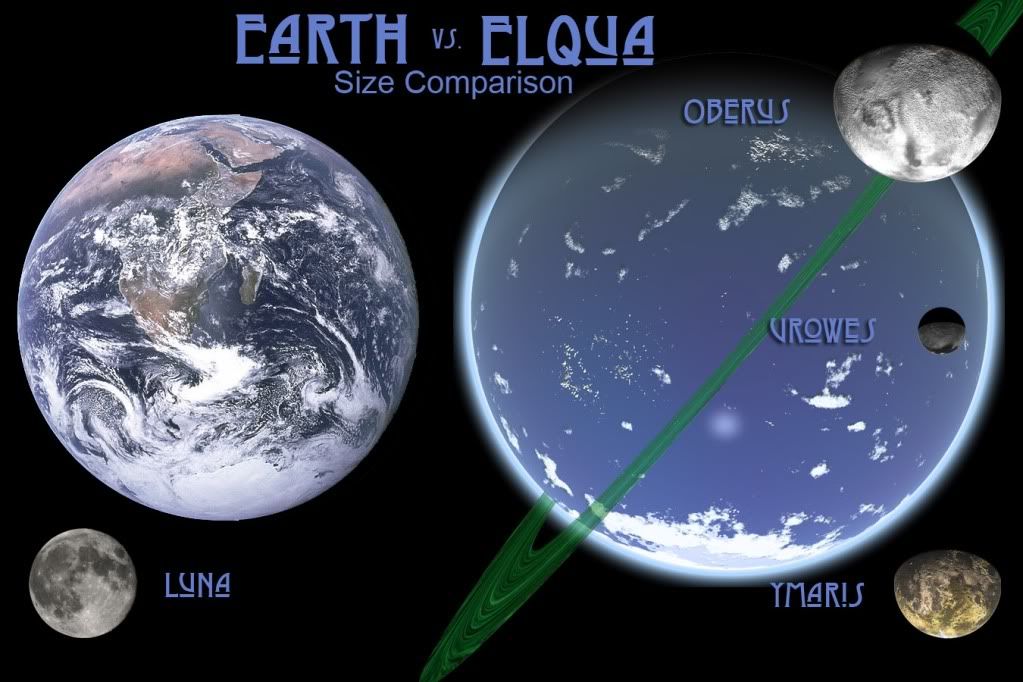The world of Elqua is a world of endless cerulean, truly a big blue marble in space. Nearly all ocean, its surface is almost utterly swallowed up with a single massive, liquid, living ecosphere in the form of a vast ocean that wraps around the planet. Placid and pristine tides belie the deep currents below, a blossoming flowering of flowing fluid, surging across the world like the pulse of a living being.
Elqua (the native language for “water”) orbits at about .92 AU around a G3 class star. A cooler yellow star than our own, it is the planet’s larger size that allows it to absorb more of its sun’s radiant energy. While the high albedo of such a large body of water would usually reflect most of the sunlight away, the high levels of carbon-dioxide and other greenhouse gasses in the atmosphere maintain a balance that keeps the ball of liquid from freezing over.
The circumference around the world’s equator is roughly 53,229 km, with a 8482.8 km radius of the geothermally-active molten core. This results in a surface area of 904,249, 587.8 sq. km, of which 95% is covered in the life-giving liquid. That comes to about 1/3rd the amount of solid surface above the waves that Earth posses.
While life has flourished in those 45,212,479.4 sq. km. of dirt and rock, it is the 1.82 billion cu. km. of ocean volume that serves as home to intelligent life. With so little contiguous land except for the plethora of archipelagoes, the opportunity for primordial creatures to crawl up out of the murky aquatic depths and onto the dry, open land rarely mattered. Instead, life flourished under the waves and mostly remained there. Creatures great and small grew and diversified, migrating to fill the empty world, dispersing across the currents and finding homes in every niche of the sparkling, virgin waters
With all extra accumulation of water above, pressure at the sea floor would outstrip anything known on Earth if not for Elqua’s lesser gravity. The water world’s mass is 1.7445 of our own planet’s, or almost 6x1024 kg. With more water and less iron contributing to the planet’s density, Elqua has a density of about 4.1 grams/cm3, resulting in a gravimetric pull just 19% shy of Earth’s own. This has helped life to reach further down into the abyssal trenches of the planet, as well as allowed for much larger organisms to develop.
Despite the preponderance of a single ecosphere, Elqua’s axis is tilted by 25°, therefore resulting in a variance in temperature and season when coupled with its orbit around the sun. The tilt of Elqua is just a degree and a half greater than that of Earth, which produces a slightly more extreme winter and summer, but a year is shorter. Cloud cover is rare during the months the hemisphere is closest to the sun, and the climate is for the most part calm due to the significantly low amount of surface land interfering with air currents. During the summer, most all cloud cover dissipates until only a few wisps are left (though the Maelstrom continues to rage on strongly, but with little visible fanfare).
This world has three satellites orbiting its peaceful surface in the form of moons, and a planetary ring. The moons are known as Oberus, Ymaris, and Urowes, genderless siblings in the seas that are the sky. Because of the innate fear nearly all life on Elqua has of the surface, very little research has been done on the triptych of satellites. Scholars of the Godless, be they brave or simply unperturbed by the legends of damnation above the planet’s waves, have begun to examine the complex clockwork of lunar orbits. The average denizen knows at best a passing reference to the moons in the narrative of mythology, while the current standard of cosmological knowledge knows little more than their waxing and waning cycles.
Ymaris is a close approximation of our moon, Luna, except for its brownish-yellow rust coloring. It has an orbit of about 20 days, a diameter of 3,443 km, and a density of 3.125 g/cm3. It has a slow, chaotic rotation due to its occasional passing through Oberus’ closer, strong gravitational field, which imparts a minor spin that fades as Ymaris circles around Elqua to meet its larger sister again.
Oberus’ orbit is further out and much slower, thus it will remain in the Elqua sky for nearly two and a half days before vanishing for the same length of time. It takes nearly 108 days for this pale moon to complete its cycle from new to full and back again. It has a diameter almost 1/3rd larger than Ymaris’ and a density of 3.586 g/ cm3. Most likely Oberus was an inner planet of the system that knocked from its stellar orbit by some type of large-mass collision and was caught in the gravity pull of Elqua. Oberus is tidally locked, meaning it does not spin, and one hemisphere always faces Elqua.
Conversely, dark Urowes rotates around the planet so quickly – and in the opposite direction that Elqua rotates (a “retrograde” orbit) -- that it will rise and fall twice in a single day, harkening the dawn and heralding the dusk. This means Urowes will be in the sky for 7 hours of the night and 7 hours of the day, with the other hours spent going around Elqua for it to rise again. Urowes is a little over 2,200 km away from the surface of Elqua, literally defining its Roche Limit (the closest a natural satellite can orbit a planet without falling back in on it due to the effects of gravity).
With its orbit so close that it practically skips along Elqua’s “event horizon”, it is this powerful velocity that prevents the tiny satellite from being drawn in by the water world’s greater gravity. To exist so close to the planet, the density of this satellite must be five or ten times that of Oberus, yet it is nearly one-tenth the size of its largest sibling. Urowes’ diameter is about half that of Ymaris, and faces Elqua on it’s wobbling axis. This makes the pivot of Urowes appear to spiral in place as its pole revolves in a whirling pattern.
Urowes is the inner guide satellite for Elqua’s planetary ring, and Ymaris is the outer guide. It is the rotation of these two “shepherd moons” that keeps the debris rings of Elqua constant. Any materials that would fly off into space or be pulled down into Elqua’s gravity are instead intercepted by the two moons. The pockmarked surface of the two satellites attests to the frequency and violence of these impacts.
Urowes is too small to block out the visual disk of the system’s sun, meaning it cannot cause a solar eclipse. However, its transit across the sun is noticeable as a black sphere skirting a quickly curved path across the yellow disk. The other two siblings are capable of eclipses – even concurrently, an event that produces a spectacular double “diamond ring” effect.
The planetary ring around Elqua is euphemistically referred to as “the Sargasso in the Sky”, and mythology equates it to the same entangling mass of seaweed that endangers those foolish-yet-inquisitive individuals to peek out of the enveloping embrace of the ocean and gaze at the ring’s hazy green tint over the constellations.







This comment has been removed by a blog administrator.
ReplyDelete